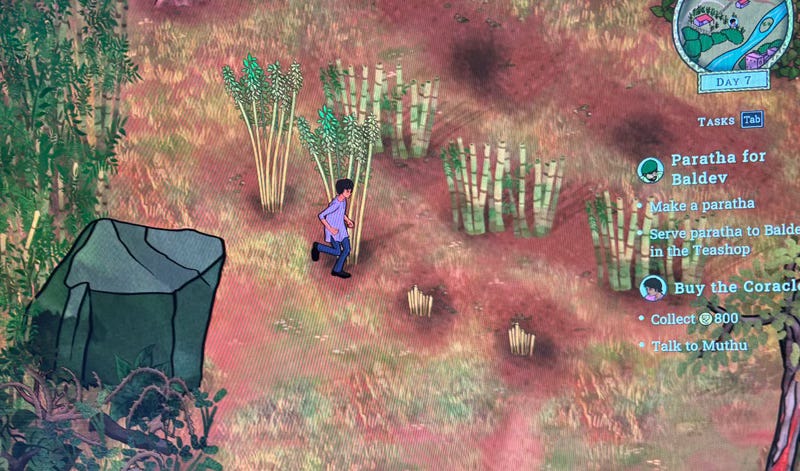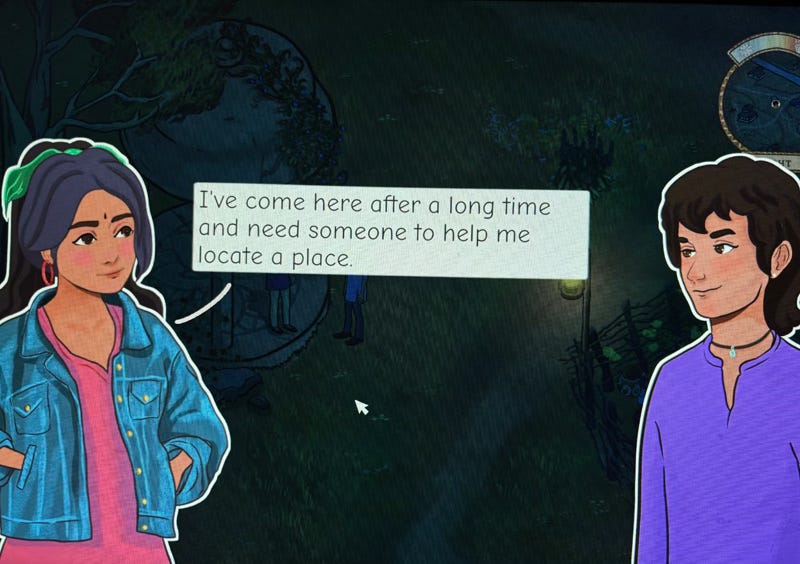THE COOKBOOK TEST #0040: THE PALACE ON THE HILL
INSTALLMENT #0040 (FREE) WELCOME TO FLAVOR VILLAGE / THE GOOD / THE BAD / THE SILLY
Dear Readers,
As some of you have already gathered, in addition to being an obsessive cook, a prolific writer, a father of two, and a remarkably bad tennis player, I am also a degenerate gamer. What's more: I don't even play the cool games, wherein you shoot characters in the head while other players scream racially-informed remarks at you through a headset. My style is a lot more "harvest and build" (Dave the Diver, Stardew Valley), or "lightly slaughter, harvest, and build" (Legend of Zelda: Breath of the Wild, Hades.)
In that vein, when I saw The Palace on the Hill pop up on Steam, I had to snag it - it's a cooking game set in an Indian village established in the midst of historical ruins, and it promised to weave together the past and present in a way that was both deep storytelling and an opportunity to harvest 24 onions after a bunch of watering and then sell them at a profit or make them into pakora. It probably didn't hurt that I took my son out to an Indian buffet for lunch the same day I spotted the game, and I could still vividly conjure up the flavors of chicken biryani, chana masala, and garlic naan with minimal effort.
In broad strokes, The Palace on the Hill is about Vir - a teenager, painter, farmer, and tea shop employee - trying to better himself through art and hard work. Meanwhile, in a very Hallmark Movie twist, former classmate Savi is back in the village from the big city, and finds herself spending a lot of time with the rustic but talented Vir.
It's not a bad story, and it digs into some classic Indian history / mythology / art tropes along the way in a manner that's entertaining and beautifully rendered.
at your service,
James
THE PALACE ON THE HILL
NIKU GAMES | AVAILABLE ON STEAM | 2024 | $20
I'm fond of The Palace on the Hill - it's a scrappy independent title telling a new story in a way that feels fresh and different. Nevertheless, it's not a perfect game.
THE GOOD
The best part of this game is unquestionably its foraging system. You run through town and the surrounding countryside harvesting, harvesting, harvesting - everything from cardamom pods to bamboo to limes to mangos to cinnamon bark to medicinal roots. The plants you farm or forage can be used to make delicious-looking food or drink to sell at the cafe, or they can be used for Ayurvedic medicine, or they can be used (in the case of jute and bamboo) to build. You can find clay, too, and that can be fired into a variety of useful cooking vessels, pickling jars, and even a lamp.
The main character's development - he's a gifted artist, but seems doomed to work in a tea shop - is handled thoughtfully, albeit with the deus ex machina of an enlightened government official that seems awfully optimistic about the role of bureaucrats in improving the lives of typical citizens. But there's a real sense of growth and motion, and the game's method for depicting the main character's painting process - gathering reference points that are then incorporated into Vir's art - is pretty elegant.
The actual food in the game is reasonably cool, too - you can make paratha with mango pickles, and saag paneer, and chai masala, among a large handful of others. The various components (spice blends, fruits, milk, etc.) are all obtainable around town, and they're complex enough to be engaging without being daunting or tedious.
THE BAD
I finished the game in six hours, and it cost $20. That's roughly $3.33 per hour of entertainment, which is quite steep. I've played games like Breath of the Wild for hundreds of hours (I know, I know, I should’ve learned basic French instead) and even at $70, it works out to far less than a buck an hour.
That wouldn't be so bad except that part of the reason the game is so short is that it feels unfinished. If you've exhausted your one or two very short interactions with most of the game's characters, all they have left for you is a "Nevermind" dialogue - nevermind the fact that it would've taken a few hours for a writer to give everyone a few throw-away dialogues to deepen their characters and give you more of a reason to chat with the NPCs.
Similarly, despite the fact that you spend a surprisingly large chunk of your six hours of gameplay pumping water on your farm, the game doesn't bother to animate that process - your character just stands near the pump.
Worse, despite how cool the dishes you cook might be in abstract, the teashop is pretty broken as a system. You can add seats, but you hardly need to because every visitor will order three times, meaning a few customers can exhaust your supplies in a hurry. Forget an order, fail to fill it, shut down the cafe before feeding anybody? Not a problem, there are no penalties for screwing up. In short: It's clunky, low-stakes, and weird. By contrast: the sushi bar in Dave the Diver absolutely nails the challenge of making running a virtual restaurant seem manageable but also challenging and fun.
THE SILLY
The game's "Mature Content Description" goes like this:
Mild teenage flirtation
Infrequent depiction of smoking
I'm not even sure if "mild" or "flirtation" are appropriate words for this warning; the relationship between the game's male and female leads certainly could have been conducive to romantic situations, what with them galavanting around jungle-covered ruined palaces together, but it most assuredly wasn't. It's about as sexy as an episode of Daniel Tiger’s Neighborhood. [1]
I've watched enough Bollywood to know that in an Indian piece of cultural content you have to tread lightly when it comes to romantic entanglements, but the relationship between the two main characters is arguably the biggest load-bearing piece of plot in The Palace on the Hill and it ultimately starts out nowhere, goes nowhere, and then finally comes to nothing.
You can pick up cow manure! That's fine, you're a farmer, early in the game you can use 12 pieces of cow manure to expand your farm to a second, larger field. But after that? There's a lot more cow manure out there, and you don't use it for anything, ever. Other resources (jute, bamboo) are similar in that you run out of uses for them, and there were several foraged plants that I never found any kind of use for, whether to sell or craft with.
THE VERDICT ON THE PALACE ON THE HILL
(BUY IT / ***BORROW IT*** / SKIP IT / SCRAP IT)
While it's difficult to "borrow" a game like this short of using a friend's computer, that would be the ideal way to experience it - it's lovely, it's fun, it's remarkably original, but it's not exactly polished and it's tremendously costly for the entertainment it provides. I'm a booster of games that are thoughtfully anchored in the real world like The Palace on the Hill and I really appreciated the vibe of foraging and cooking in an Indian village - if you pushed me to render a "recommend" or "don't recommend," I'd recommend it for being eye-opening and creative.
[1] NOT VERY SEXY.









